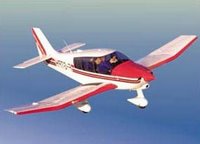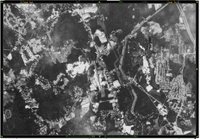As Hades says in Disney's Hercules, "Two thumbs WAY, way up!" This was a great flight (it was with Valley Flight Center, 818/444-7739). I even did maybe 80% of the landing! The CFI was supposed to be "Brian," and maybe that's his nickname, but he's actually Sergio Guevara, Jr., and he has 1700+ hours, CFI/CFII, working on multi-engine with hopes for ATP and airline flying. Nice guy, and very instructional (kept quizzing me on various stuff on the preflight checks, e.g., FAA no longer requires that a radio license be in the aircraft with the air worthiness and registration, but the POH must still be there – I didn't know some things like "dorsal fin," the forward extension of the vertical stabilizer – gotta study harder I guess).
ANYWAY, we did a real thorough pre-flight (but no paper checklist for the outside walkaround – I would have to buy a handbook for that, and he knew it, as did I from this morning – we could have used the POH itself, but I would have gotten oil and gas on it like this morning at CCB). He even put water in a fuel sample to show me what that looks like (sinks to bottom, color is different, beads up on ground). We had to tighten screw on the right wing. Switch to bullets (as opposed to AMRAAMs?):
· I really like that little C152, and I may try to switch to C150 back home and save some money.
· I made the radio calls and did pretty well thanks to some recent practice with sound files I got from the web (ATIS and other radio samples in VOX format). Got ATIS, requested taxi clearance and takeoff, and even called the tower when we were at the West Covina Mall heading west for landing.
· I did the takeoff myself (wind was 190° at 14 kts, essentially straight down the runway, no crosswind), swerving a bit on the rudders, but not too bad (I made sure the door was securely latched this time!). Got fast on climbout (80 kts -- you want to gain altitude fast over the I-10 and other dense ground features, so cruise climb has to wait – 65 kts for best rate I believe – if I knew which plane I was flying back home now, I would have bought a handbook and checklists, because both Valley and F.A.S.T. down the street had these for C150, 152, 172, etc.).
· We had asked for a left downwind (north) departure to the Santa Fe Dam practice area, just a few minutes away. I tried to scan for traffic and I did not particularly notice any ground features other than the I-10 and I-605 freeways.
· We started with climbing to 3500' and then did some turns at various bank angles – as usual, I was overcorrecting. One problem I have is overcontrolling for the overbanking tendency in steep turns (30 and 45° today) – it only requires a slight touch of opposite aileron, and if you add too much, it shallows out the bank. I did this a lot but improved a little, and I did one really nice 45 degree bank (feels steeper than that – you can feel the 1.4G's)
· Speaking of G's, I couple of times I pulled a few more (maybe 2?) when I started to let the nose go down too much then added power and pulled up too abruptly. CFI didn't say anything. My altitude control in turns was so-so.
· There was one close airplane that I spotted at my 9 o'clock, turning away (west) from us on the way to the practice area. I think he was maybe 2000 feet away and only 300 feet below us when I saw him – some sort of Piper. I spotted and called clock positions on other traffic a few times, 5+ miles away, except for an escaped helium balloon that passed us at 2500 feet near the mall!
· We did both power-off and power-on stalls, with flaps (landing and takeoff configs) – cool, though I didn't really feel the pre-stall buffet (I heard the horn loud & clear though). The nose seems WAY, way high, but I know it's not. I lost over 200' on the second stall.
· After the stalls when I was straight and level again (at 3000 feet I think), he cut the throttle to idle and said "What if you lose your engine right now, what do you do?" I said, OK, establish best glide speed (he said good, 60 kts, do it), then I proceeded to put the nose DOWN and speed up to 90+ knots! DUH! So then I'm saying, look for an airport (nope, we don't have one), or a flat, open field to land on – there's a sports field just to the left, there's another one. He said "what about that big dirt field there to the right?" It looked like one of the quarries near Duarte to me! But on closer inspection there was one that looked like a huge parking lot under construction. I made a shallow bank that would have made the field, then he said add power and make for EMT. It was cool that he pulled this on the demo flight – he was really testing my knowledge and maybe even "coolness under pressure" (I know this was low key – any "coolness" I may have WILL be tested more in the future I'm sure). One funny thing is that I don't feel any sense of fear with this stuff – stalls, simulated engine failure, steep turns, etc. all seem OK to me. My nervousness is performance pressure – I want to show the CFI that I can do all this stuff.
· The CFI basically told me where to start my turns for most maneuvers, calling out headings (I got better at rolling out on heading, still a little sloppy, but close – I only forgot to lift my wing to check for traffic once or twice). This was true especially when we entered the pattern – I tried to note my position and altitude, but I missed a lot (I was pretty jazzed by the end of the hour and started overcontrolling more again after improving in mid-flight – thinking about tuning and getting ATIS and calling the tower for landing got me flustered as I was trying to follow the I-10 back to the airport – BTW, need to keep such ground reference features a bit further to my left so I can keep the freeway in sight – those freeways are great nav aids, though!).
· When he had me start the turn to final (he was making the radio calls after I called the downwind), I couldn't believe he wasn't taking the airplane! He was guiding me on adding flaps, reducing throttle, carb heat, adjusting lineup, but I did all of that myself! (He may have tweaked the controls a time or two.) When we got over the threshold, he had me pulling the yoke back, and I actually flared to a very slight bump and landing (he added a skosh of power at the flare I believe to slow the descent a bit). This was shocking, but actually quite cool! At Hopedale, the landings seem to go too fast, but in this case I was involved in it, and it seemed OK, or at least possible!
· One slight worry on the turn to final – I hesitated (checked traffic maybe?) and started the turn a tad late, so I had to steepen it to get aligned with the runway. I remember reading that this is a spot where accidents happen, when the pilot misjudges the timing or the wind, and you are fairly close to stall speed (not to mention the ground). This can be a problem especially because of the increased stall speed you have in a bank, though it probably was not more than 30° (you should not do more than 30°of bank in the pattern).
· I held back pressure to slow us then applied brakes and turned left at the center to go to the fuel pit – tower ignored my call for this, so we switched to ground anyway and got permission. My taxiing was still not smooth, but the best effort so far, even using differential braking. One thing is for sure – with all the visual and physical information, landing the real airplane is WAY easier than landing in FS95! I never mentioned flight sims to either CFI today – it just didn't seem especially relevent.
I guess the bottom line is that it is starting to feel a bit familiar and if not easy, at least "doable." Brian/Sergio said I did well on everything except that over-control thing – I really need to work on that part. It was really a fun flight – in a way he really threw me into the deep end of the pool and covered a lot of topics for a demo flight. In my log book, he noted "Demo flight, preflight, taxi, runup, takeoff, stalls power on/off" – an excellent lesson for my 60 bucks. And today I more than tripled my logged flight time (TT from 0.6 hours to 2.1 hours). I think I can solo this fall if I can just get those weekly flights in with Jason! Note: FLY WITH THE LEFT HAND! Have to keep the right free for throttle and radios and all, so get used to it. Also, TRIM and USE A LIGHT TOUCH ON THE CONTROLS.
Time: Dual 1.0 hrs, TT 2.1 hrs (C152 at EMT)
 This was a surprise "bonus" flight during my business trip to Oberkochen, Germany, traveling with our German distributor's technical sales guy, Jörg. I saw low-flying Cessnas and other light planes from our hotel in Aalen-Waldhausen and found that there's a general aviation and gliding center at "Flugplatz Elchingen," about 15 minutes away. I had Jörg drive us over and found sightseeing flights for 40 DM a person (about $23 – he paid as I had no DM!). Jörg had never flown in a light plane (a French "Robin," low-wing 4 seat with great visibility), but he was a good sport and gave me the front seat.
This was a surprise "bonus" flight during my business trip to Oberkochen, Germany, traveling with our German distributor's technical sales guy, Jörg. I saw low-flying Cessnas and other light planes from our hotel in Aalen-Waldhausen and found that there's a general aviation and gliding center at "Flugplatz Elchingen," about 15 minutes away. I had Jörg drive us over and found sightseeing flights for 40 DM a person (about $23 – he paid as I had no DM!). Jörg had never flown in a light plane (a French "Robin," low-wing 4 seat with great visibility), but he was a good sport and gave me the front seat. 